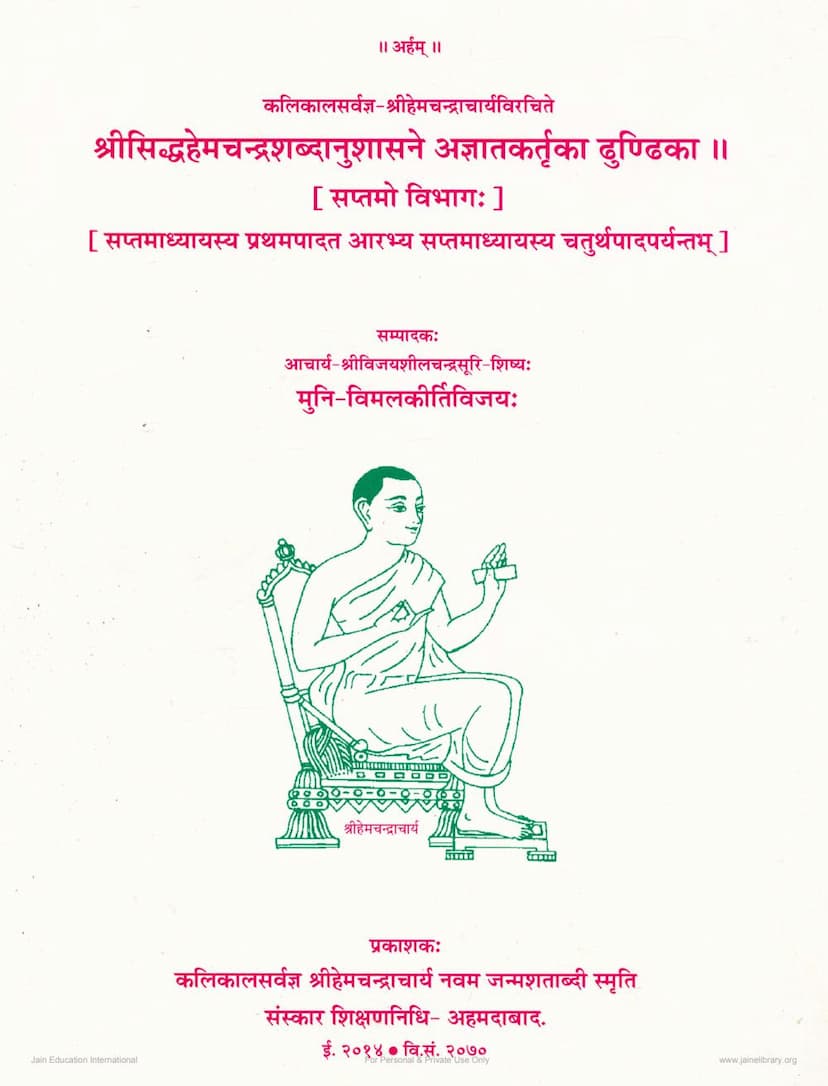Siddha Hemchandra Shabdanushasane Agyat Kartuka Dhundika Part 07
Added to library: September 2, 2025

Summary
This comprehensive summary covers the content of "Siddha Hemchandra Shabdanushasane Agyat Kartuka Dhundika Part 07" by Vimalkirtivijay, based on the provided pages and catalog link.
Book Title: Siddha Hemchandra Shabdanushasane Agyat Kartuka Dhundika Part 07 Author: Muni Vimalkirtivijay (Disciple of Acharya Shri Vijayshilchandrasuri) Publisher: Kalikal Sarvagya Shri Hemchandracharya Navam Janmashatabdi Smruti Sanskar Shikshannidhi, Ahmedabad Publication Year: 2014 CE / 2070 VS (Veer Nirvana Samvat 2540)
Overall Summary:
This volume (Part 07) is a significant part of the "Dhundika" commentary on Acharya Hemachandra's renowned Sanskrit grammar, "Siddha Hemchandra Shabdanushasanam." The "Dhundika" commentary is known for its detailed explanations and derivations of grammatical rules, particularly focusing on the "Taddhita" (derivational affixes) section. This specific volume covers the first four Padas (sections) of the seventh Adhyaya (chapter) of the "Siddha Hemchandra Shabdanushasanam," which primarily deals with the Taddhita prakarana (chapter on derivational affixes).
The text is presented as an "Agyat Kartuka Dhundika," meaning the author of the original commentary is unknown. However, the current publication is edited and compiled by Muni Vimalkirtivijay under the guidance of Acharya Shri Vijayshilchandrasuri. The publisher, Kalikal Sarvagya Shri Hemchandracharya Navam Janmashatabdi Smruti Sanskar Shikshannidhi, Ahmedabad, highlights their commitment to publishing rare and unprinted Jain literature, especially works related to Acharya Hemachandra, as part of their mission to commemorate his birth anniversary.
Key Highlights from the Provided Pages:
- Content Focus: The primary subject matter of this volume is the extensive Taddhita Prakarana (Chapter on Derivational Affixes) of the Siddha Hemchandra grammar. Specifically, it covers the rules related to the formation of words by adding suffixes to existing roots or words, explaining their derivation, meaning, and application.
- Editorial Work: Muni Vimalkirtivijay is credited with the meticulous task of transcribing and editing the text from handwritten manuscripts found in Jain knowledge repositories. The editor expresses gratitude for the opportunity to bring this "unprinted" work to light, acknowledging it as a contribution to Jain scholarship and the study of Sanskrit grammar.
- Publisher's Mission: The publishing institution emphasizes its dedication to researching and publishing unpublished works of Jain acharyas, as well as reprinting rare texts with corrections. They also publish a research journal named 'Anusandhan'.
- Hemachandra's Contribution: The text acknowledges Acharya Hemachandra's monumental work in compiling the "Siddha Hemchandra Shabdanushasanam" with the aim of removing complexities and Vedic-centric usage prevalent in earlier grammars.
- Structure of the Volume: The table of contents (pages 10-23) provides a detailed breakdown of the sutras (grammatical rules) covered within the seven chapters and their respective parts. This volume specifically focuses on Chapter 7, Padas 1, 2, 3, and 4, extensively detailing the Taddhita rules within these sections.
- Methodology of the Commentary: The "Dhundika" commentary likely provides detailed explanations of each sutra, including its components (padachheda), divisions, compounds (samasa), meaning (artha), examples (udaharan), and justifications (siddhi). The included index also lists specific roots, affixes, and derived words, indicating a rigorous analytical approach.
- Appreciation and Impact: The editorial notes include testimonials from scholars and religious figures who praise Muni Vimalkirtivijay's work for making Sanskrit grammar studies more accessible and beneficial. The publication is seen as a valuable resource for students and researchers of grammar, contributing significantly to the Jain community and the wider academic world.
- Dedication: The work is dedicated to the spiritual teacher of the editor, Acharya Shri Vijayshilchandrasuri Maharaj, highlighting the importance of the guru-shishya tradition in Jain learning.
- References: The bibliography lists several other important grammatical works, primarily on the Siddha Hemchandra grammar, showcasing the editor's extensive research and the textual lineage.
Specific Grammatical Topics Covered (Based on the Table of Contents and interspersed examples):
The Taddhita prakarana, as covered in this volume, involves the application of numerous suffixes to derive new words. The content likely includes rules related to:
- Suffixes indicating relation or belonging: Such as the 'ya' (य), 'eyana' (एयण), 'ina' (ईन), 'ikaNa' (इकण), and 'a' (अ) suffixes (e.g., from roots like 'vah' - to carry, 'hṛd' - heart).
- Suffixes indicating causation or modification: Such as 'kara' (क), 'ak' (अक), 'ya' (य), 'ikaNa' (इकण), 'ti' (ति), 'kapyanta' (कप्), 'kta' (क्त), 'kvip' (क्विप्), 'kyap' (क्यप्) etc.
- Suffixes indicating possession or having: Such as 'matu' (मत्), 'vin' (इन्), 'vala' (वल), 'valaR' (वलच्), 'mina' (इमन्), 'ila' (इल), etc.
- Suffixes indicating similarity or resemblance: Such as 'mayaṭ' (मय), 'kalpa' (कल्प), 'daśya' (देश्य), 'deśīya' (देशीय).
- Suffixes indicating superiority or comparison: Such as 'tamaP' (तमप्), 'tarap' (तरप्), 'iṣṭha' (इष्ठ), 'īyas' (ईयसु).
- Suffixes related to time and place: Such as 'a' (अ), 'ya' (य), 'taddhita' (तद्धिते), 'aN' (अ), 'ta' (त), 'tas' (तस्), 'thA' (था), 'dhA' (धा), 'thak' (थक्), 'dyu' (द्युस्), 'en' (एन), 'ina' (ईन), 'ya' (य), 'eya' (एय), 'eyya' (एय), 'iya' (इय), 'ika' (इक), 'ilu' (इल), etc.
- Specific rules for certain noun classes: The text details specific rules for words like 'na(ni)', 'vrihi', 'śālā', 'dhan', 'gaṇa', 'pūga', 'saṅgha', 'śata', 'sahasra', 'lakṣa', 'viṁśati', 'triṁśat', 'pañcāśat', etc.
- Causative verbs and their derivations: The commentary delves into how roots are modified to form causative verbs and their subsequent derivations with suffixes.
- Emphasis on exceptions and nuances: The commentary highlights the exceptions and specific contexts where these rules apply, often referencing other grammatical texts or the nuances of Sanskrit usage.
The book provides a very detailed, sutra-by-sutra analysis of these derivational processes, offering examples and explanations that are crucial for understanding the formation of Sanskrit words within the framework of Hemachandra's grammar.